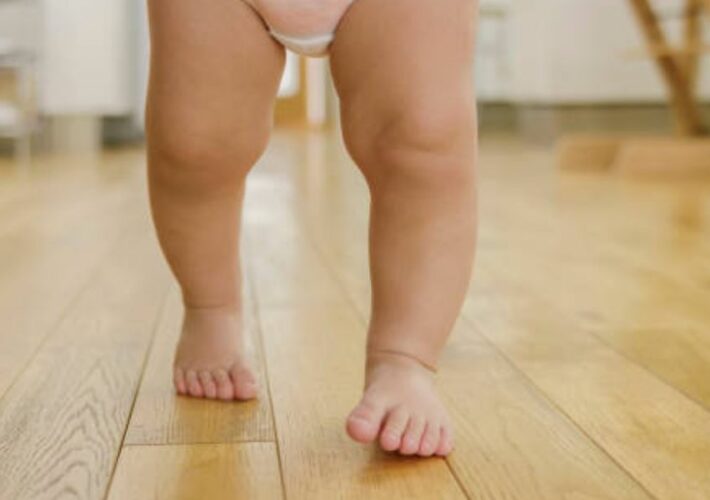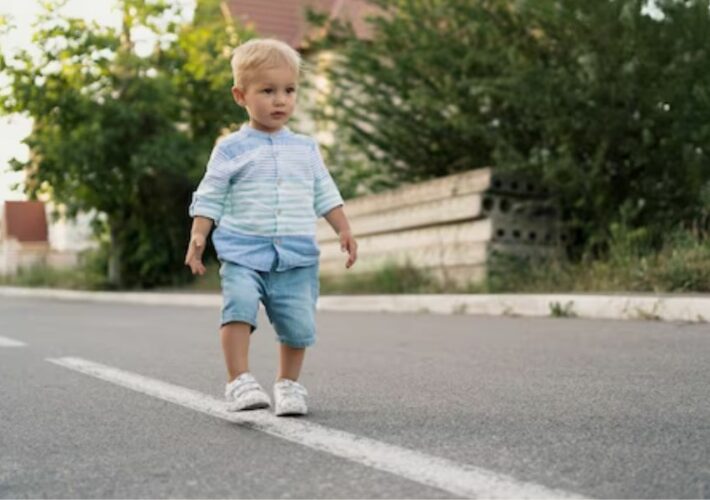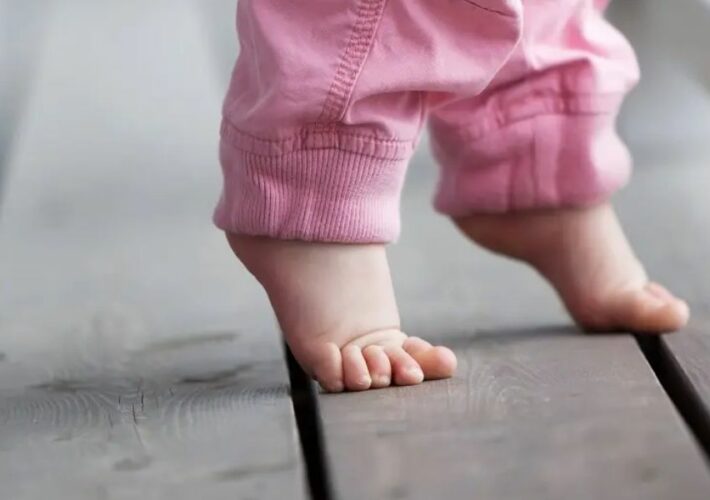As babies, we learn to crawl and then take our first steps. Walking is a complex skill that requires coordination between the brain, muscles, and bones. However, not all children develop in the same way, and some may show variations in their gait pattern. These variations can be worrying for parents, but in most cases, they are normal and don’t require medical attention. In this article, we will discuss some of the most common variations in gait and when to seek professional help.
TL;DR – the highlights:
- some children may show variations in their gait pattern, which in most cases are part of normal development
- most cases are physiological and improve spontaneously with growth
- when should we worry – if the condition lasts longer than a certain age, is present only on one side or causes pain
- it’s important to be aware of red flags
When are variations in gait part of normal development?
Many parents seek medical attention because of the appearance of their child’s lower limbs, or because of concerns that their child’s condition could lead to degenerative musculoskeletal problems or a reduction in their athletic ability. In most cases, the problem is a variation of normal development that follows a benign and predictable course. Rarely does the problem persist into adolescence or require treatment.
Toe walking, flat feet, bow legs and knock knees and intoeing can all be part of normal gait development, but often cause undue concern to parents, leading to frequent visits to general practice. A significant proportion of referrals to a pediatrician or orthopedist consist of normal physiological variations in growing children, but the key point is that the physiological variations resolve spontaneously.
In this article, we want to help you recognize normal physiological variations of the lower limbs in children and identify abnormal features that require specialist attention.
Toe walking
Toe walking is a common variation in gait among children. It’s when the child walks on their toes instead of the whole foot. In some cases, this can be normal, especially in younger children who are still learning to walk. However, if a child continues to toe walk beyond the age of 2 or 3, this may indicate an underlying condition. Idiopathic toe walking is defined as “persistent toe walking after 2 years of age in healthy children without a neurological or orthopedic diagnosis”. It’s thought to be due to relative shortening of the soleus or gastrocnemius muscles, which effectively tightens the Achilles tendon.1
Abnormalities: One of the most common causes of toe walking is tightness in the calf muscles. This can be due to a variety of reasons, including muscle or nerve disorders, cerebral palsy, or a congenital condition. In some cases, toe walking can also be a sign of autism spectrum disorder or sensory processing disorder.
Red flags: It’s important to seek professional help if your child continues to toe walk beyond the age of 2 or 3 or if they only walk on their toes and cannot walk flat-footed or if toe walking is unilateral. Other red flags include difficulty walking, frequent falls, or if toe walking is accompanied by pain or discomfort.
Treatment: Treatment for toe walking varies depending on the underlying cause. In some cases, stretching exercises or physical therapy may be recommended to improve range of motion and flexibility. Most cases of idiopathic toe walking will improve spontaneously but for those that don’t, various treatments are suggested, such as stretching techniques, serial casting, night braces and ankle-foot orthoses.1 In more severe cases, surgery may be needed to release tight muscles or tendons.
Flat feet
Flat feet, also known as pes planus, is a condition in which the arch of the foot is flattened, causing the entire foot to come into contact with the ground. This can affect the child’s gait, causing them to walk with their feet turned outwards. Flexible flat feet often run in families and are thought to be more common in those children who wear shoes, are obese or have general laxity of the ligaments.2 In a preschool child, the longitudinal arch is usually covered by plantar fat. As the child grows, plantar fat is resorbed, muscles develop, and joint laxity decreases, leading to the formation of a medial arch. The medial arch usually appears between 2 and 3 years of age.
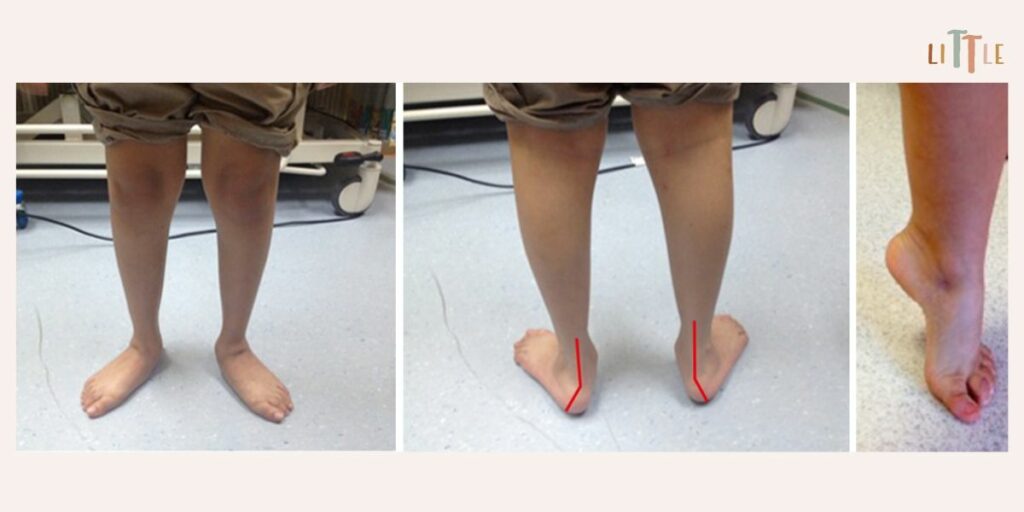
Abnormalities: Flat feet are common in young children and often resolve on their own as the child grows. However, in some cases, flat feet can be a sign of an underlying condition, such as a neuromuscular disorder or connective tissue disease.
Red flags: If flat feet are causing pain, difficulty walking or standing, or if they only affect one foot, it is important to seek professional help. Additionally, if s child’s flat feet persist after 6 or 7 years of age, it may be a cause for concern.
Treatment: Treatment for flat feet depends on the underlying cause. In most cases, no treatment is necessary and the child will outgrow the condition. However, if flat feet cause pain or difficulty walking, treatment may be necessary. This may include physical therapy, shoe insoles or orthotics.
Intoeing
Intoeing, also known as pigeon-toed, is a condition where a child’s feet turn inward when walking or standing. This can affect the child’s gait, causing them to walk with their feet turned inward and tripping more. The cause of intoeing varies according to the age of the child. In the first year of life, it’s usually due to metatarsus adductus. In toddlers it may result from internal tibial torsion or in combination with metatarsus adductus. And in early childhood femoral anteversion is the most common cause.2
Abnormalities: Intoeing is common in young children and often resolves on its own as the child ages. However, in some cases, intoeing can be a sign of an underlying condition, such as a neuromuscular disorder or bone deformity.
Red flags: If intoeing causes pain, difficulty walking or standing, or if it only affects one leg, it’s important to seek professional help. In addition, it may be cause for concern if the child’s intoeing continues beyond the age of 8 or 9.
Treatment: Treatment for intoeing depends on the underlying cause. In most cases, no treatment is necessary and the child will outgrow the condition. Braces, shoe modifications or orthotics have been shown to be ineffective and are not recommended.2 However, if the intoeing causes pain or difficulty walking, treatment may be necessary. This may include physical therapy, serial casting (in the case of metatarsus adductus), or surgery in more severe cases.1
Bow legs
Bow legs, also known as genu varum, is a condition in which the legs bend outwards, causing the knees to be apart when standing with the feet together. This can affect the child’s gait, causing them to walk with their feet turned outwards. Symmetric bowing of the lower limbs by the age of 2 years is usually physiological and usually spontaneously corrects before the age of 4 years.2
Abnormalities: Bow legs are common in young children and often resolve on their own as the child grows. However, in some cases, bow legs can be a sign of an underlying condition, such as rickets or Blount’s disease.1
Red flags: If bow legs persist after the age of 7 or 8, this may be a cause for concern.4 Other red flags include difficulty walking, pain or discomfort, or if the condition is only present on one side.1
Treatment: Treatment for bow legs depends on the underlying cause. In most cases, no treatment is necessary, and the child will outgrow the condition. However, if the bow legs are causing pain or difficulty walking, treatment may be necessary. This can include physical therapy, braces, or surgery in more severe cases.
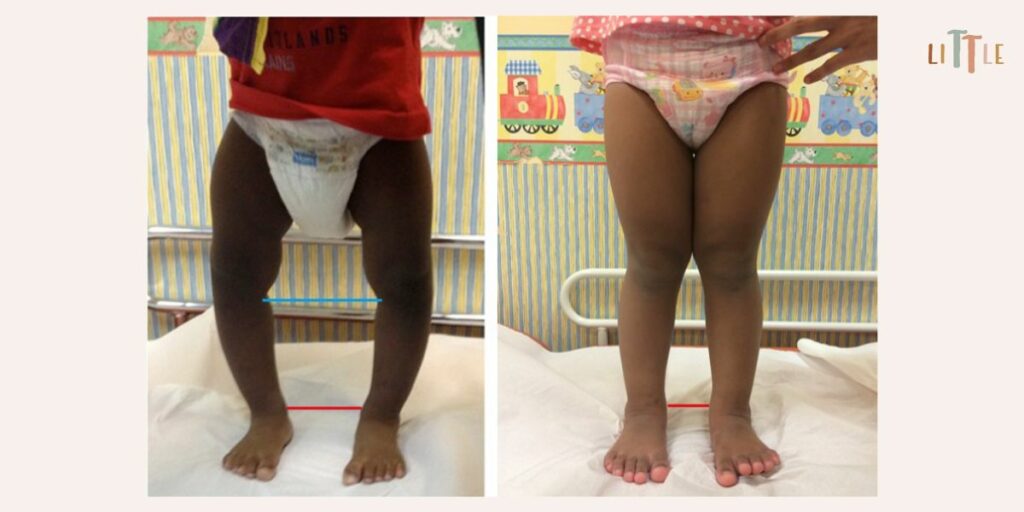
Knock-knees
Knock-knees, also known as genu valgum, is a condition where the legs bend inwards, causing the knees to touch when standing with the feet together. This can affect the child’s gait, causing them to walk with their feet turned inwards. Genu valgum is common in the growing toddler as genu varum corrects into genu valgum and then into normal valgus alignment in adults.
Abnormalities: Knock-knees are common in young children and often resolve on their own as the child gets older. However, in some cases, knock-knees can be a sign of an underlying condition, such as bone deformity or vitamin D deficiency. It’s also common in overweight children.1
Red flags: If knock-knees persist after age 7 or 8, this may be cause for concern.4 Other red flags include difficulty walking, pain or discomfort, or if the condition is only present on one side.1
Treatment: Treatment for knock-knees depends on the underlying cause. In most cases, no treatment is necessary and the child will outgrow the condition. However, if knock-knees cause pain or difficulty walking, treatment may be necessary. This may include physical therapy, orthotics, or surgery in more severe cases.
| Age of presentation | Management | |
|---|---|---|
| toe walking | up to 2 or 3 years | most cases resolve spontaneously, some cases may require stretching techniques, serial casting, night braces or ankle-foot orthoses |
| flat feet | all ages | parental reassurance, in some cases shoe insoles may be beneficial |
| metatarsus adductus | 1st year | most cases resolve spontaneously however severe deformities may require serial casting/surgery |
| internal tibial torsion | 2 – 4 years | resolves in the majority though corrective tibial osteotomies may be required if the deformity is persistent after 8 years of age |
| femoral anteversion | 4 – 7 years | resolves in the majority though corrective femoral osteotomies may be required if the deformity is persistent after 8 years of age |
| bow legs | up to 2 years | usually resolve by 4 years of age without any intervention |
| knock-knees | beyond 2 years | surgery may be required if the deformity fails to resolve spontaneously |
Variations in gait are common in children and can often be a normal part of development. However, it’s important to be aware of red flags and seek professional help if you are concerned about your child’s gait. Early intervention and treatment can help prevent further complications and ensure optimal development. As a parent, you can help ensure your child’s long-term health and well-being by paying attention to your child’s gait and seeking professional help when needed.
REFERENCES
- Johnston, L., Eastwood, D. & Jacobs, B. (2014) Variations in normal gait development. Paediatrics and Child Health, 24(5), 204– 207. doi: https://doi.org/10.1016/j.paed.2014.03.006
- Jones S, Khandekar S, Tolessa E. Normal variants of the lower limbs in pediatric orthopedics. International Journal of Clinical Medicine. 2013;4(07):12. doi: 10.4236/ijcm.2013.47A2004
- Yeo A, James K, Ramachandran M. Normal lower limb variants in children. BMJ. 2015 Jul 7;350:h3394. doi: 10.1136/bmj.h3394
- Bruce RW Jr. Torsional and angular deformities. Pediatr Clin North Am. 1996 Aug;43(4):867-81. doi: 10.1016/s0031-3955(05)70439-9


